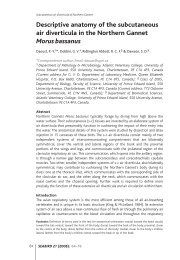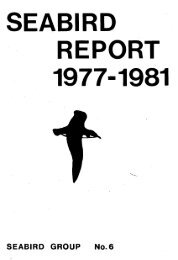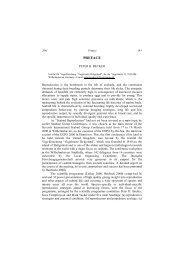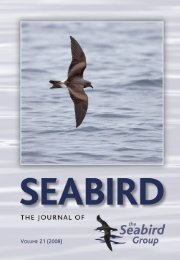Vol 6 No. 2 - The Seabird Group
Vol 6 No. 2 - The Seabird Group
Vol 6 No. 2 - The Seabird Group
Create successful ePaper yourself
Turn your PDF publications into a flip-book with our unique Google optimized e-Paper software.
40 R.T. BARRETT ET AL. Atlantic <strong>Seabird</strong>s 6(2)<br />
T otal s toc k (mill. t)<br />
9<br />
8<br />
7<br />
6<br />
5<br />
4<br />
3<br />
2<br />
1<br />
0<br />
1 98 0 1985 1990 1995 200 0<br />
Figure 3.Estimates of total biomass (solid line) and median value of the modelled<br />
stochastic spawning stock (broken line) of capelin in the Barents Sea, 1980-<br />
2003. (Source: ICES 2003).<br />
Figuur 3.Schatting van de totale biomassa (doorlopende lijn) en mediane waarde van<br />
de gemodelleerde stochastische populatie (onderbroken lijn) van Lodde in de<br />
Barents Sea, 1980-2003. (Bron: ICES 2003).<br />
Why did the birds starve? <strong>The</strong>re are many reports of seabird wrecks from the<br />
<strong>No</strong>rth Sea and one recent one (March/April 2002) from central <strong>No</strong>rway, but in<br />
most instances the victims have usually been auks Alcidae (Underwood &<br />
Stowe 1984, Weir et al. 1996, Anker-Nilssen et al. 2003). <strong>The</strong> main cause of<br />
death in all cases was starvation, generally as a result of poor weather<br />
preventing birds feeding.<br />
As far as we are aware, this episode is only the second known wreck<br />
involving kittiwakes alone. <strong>The</strong> first was on the south-west coast of Britain in<br />
January and February 1957, when many birds were found dead or with<br />
symptoms very similar to those recorded here ("tame", "tired", "lethargic", etc.;<br />
McCartan 1958). Post-mortem examinations of the British birds also showed<br />
severe starvation as the cause of death but, in contrast to the present episode,<br />
this was probably the result of prolonged gales in the <strong>No</strong>rth Atlantic carrying the<br />
birds away from their regular feeding grounds (McCartan 1958).<br />
Another winter incident in Shetland in 1993 also involved storm-driven<br />
birds, but the situation then was exacerbated by oiling from the wreck of the<br />
Braer, 94% of the recovered birds being reported as oiled (Weir et al. 1996).<br />
0,7<br />
0,6<br />
0,5<br />
0,4<br />
0,3<br />
0,2<br />
0,1<br />
0<br />
Sp aw nin g s to ck (mill. t)








